Outdoor Living
Patio Umbrella Buying Guide: How to Choose an Outdoor Umbrella
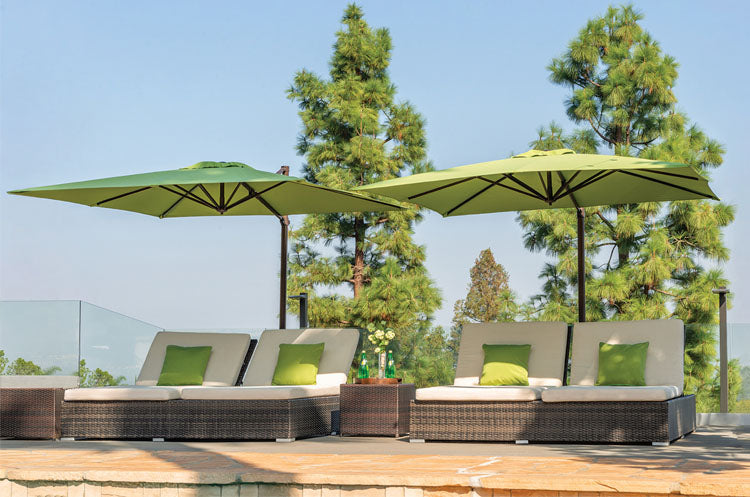
A patio umbrella is a practical and attractive accessory to enhance multi-season outdoor living, offering shade from bright sunlight and even some rain protection on a patio or deck. Consult our Patio Umbrella Buying Guide to learn more about the different types, fabrics, frame materials, sizes, and special features that come together in the perfect umbrella for your outdoor space.
Patio Umbrella Designs & Styles
Explore patio umbrellas in market or cantilever styles, or umbrellas made with a tilt feature, to determine the best option to shade your outdoor space:
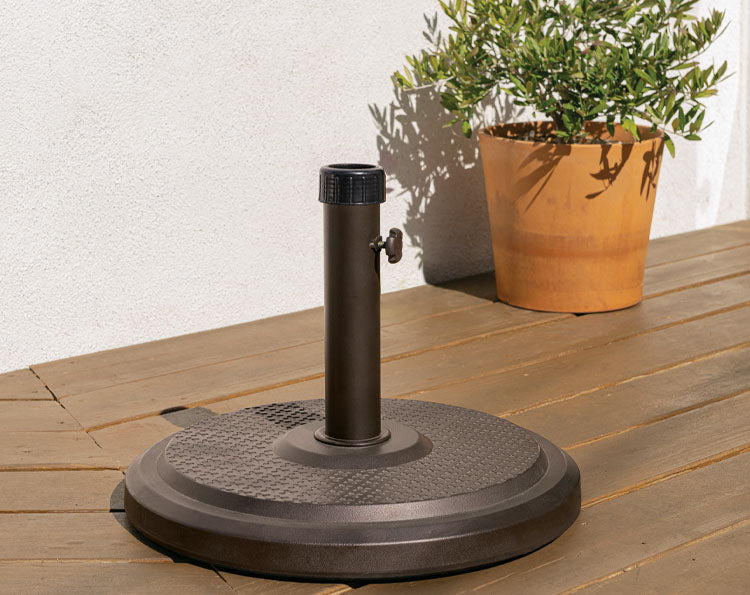
Market Umbrellas
A market umbrella, also called a center pole umbrella, is supported by a pole set in the middle of the unit that rests inside a sturdy base or a stand. Because many outdoor accent and dining tables already come with a center hole to accommodate an umbrella, the market style is a popular option.
Cantilever Umbrellas
A cantilever umbrella, also known as an offset umbrella, is suspended in the air and supported from the side. This type of umbrella offers unobstructed views, and tilts and pivots effortlessly for shade adjustment poolside or over a lounge set. A cantilever umbrella is an ideal option for a dining table without a center hole.
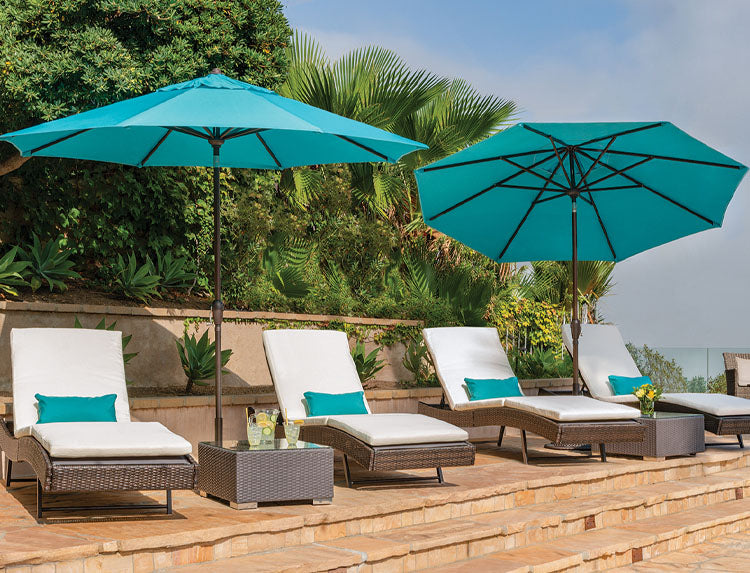
Tilt Umbrellas
A tilt umbrella may be the best choice if you need to adjust the shade on your patio frequently for sun protection. This type of outdoor umbrella adjusts with a push button, collar, or crank.
Umbrella Pole & Frame Materials
The most common umbrella pole and frame materials are fiberglass, aluminum, and wood. Choose based on the feature that’s most important to you, whether it’s performance, looks, or both.
- Fiberglass umbrellas – Fiberglass is flexible, so it won’t bend or break when the wind picks up; a fiberglass umbrella may be the best option if you live in a windy climate.
- Aluminum umbrellas – Sturdy, lightweight, and low maintenance, aluminum is a solid metal that holds up in any weather conditions.
- Wood umbrellas – Made in teak, bamboo, eucalyptus, or other wood, these classic umbrellas are treated and sealed for protection. But wood is not as durable or flexible as other materials in windy conditions.
Pro Tip: An aluminum umbrella with a powder-coated finish resists rust—ideal if you live in a moist or humid climate.

The Best Patio Umbrella Fabrics
When choosing a fabric for your patio umbrella, consider the style you like, the durability you need, and the climate it must endure. Patio umbrella fabrics that check all the boxes include Sunbrella™, olefin, acrylic, and polyester.
Sunbrella fabric – Sunbrella is a proprietary material made for patio umbrellas, outdoor sofas, and furniture cushions. This fabric is fade-, mildew-, stain-, and water-resistant; it’s also easy to clean and offers UV protection.
Olefin – This synthetic fiber is made of polyolefin. It’s easy to clean and resists fading, mildew, moisture, and wear. Quick-dry olefin is ideal for a moist or humid climate.
Acrylic – A top-quality umbrella fabric that offers UV protection and resists fading, acrylic repels mildew, water, and stains. Acrylic fabric comes in a variety of hues for a vibrant splash of color on your patio.
Polyester – Comparable in quality to olefin and acrylic, polyester resists mold and mildew. It also dries quickly—ideal if you live in a rainy climate. Polyester retains its original color well thanks to fade resistance and UV protection.
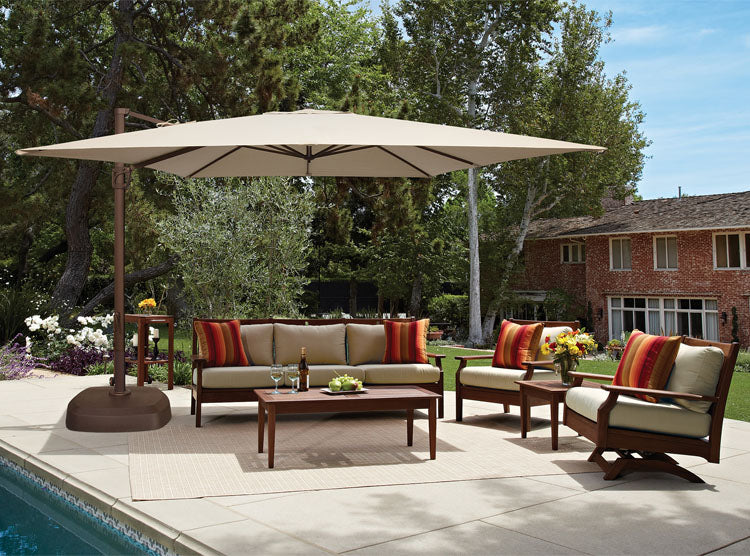
Patio Umbrella Shapes & Sizes
The three main umbrella shapes are rectangular, square, and round. When shopping for a patio umbrella by shape, consider the size of your patio, the shape of your table, and the amount of shade coverage you prefer. Select a market or tilt umbrella in the same shape as the patio table it will cover: rectangle over a rectangle, round over round. For a cantilever umbrella placed poolside or over a patio conversation set, the shape is less important; instead, choose one correctly proportioned for your space.
How To Choose a Patio Umbrella Based on Height and Diameter
The height of the pole and the diameter of the canopy shade are variables that will help inform the right umbrella size for your patio. Choose an umbrella pole height of six feet or more to ensure everyone sits comfortably with plenty of head clearance.
Choose your canopy diameter based on the size of your patio table: For tables between 30 and 38 inches, select a canopy diameter between 6 and 9 feet. For tables between 40 and 50 inches, a 9- to 11-foot shade works best. For large tables measuring from 52 to 62 inches, choose a canopy diameter of at least 11 feet.
Pro Tip: Purchase a patio umbrella that’s wider than your table by at least two feet on both sides. The extra footage offers enough shade to keep everyone cool and dry.
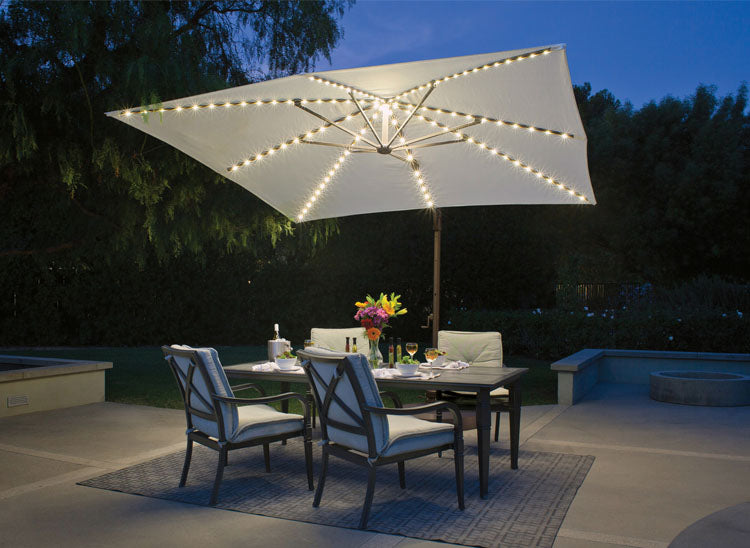
What Features Should You Consider for a Patio Umbrella?
While there are many to consider, here are a few special features to look for when choosing a patio umbrella:
- LED lights that add ambiance and illuminate your patio
- The type of tilt mechanism, including push-button, collar, and rotational
- Lift mechanisms for opening and closing the canopy: crank, pulley, or push-up
- A cover that protects your canopy shade from the elements when you aren’t using the umbrella
Now that you’ve explored our comprehensive buying guidelines, browse our selection of patio umbrellas to find the best option for your outdoor space.












